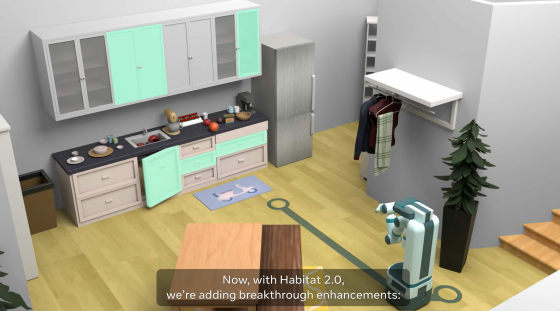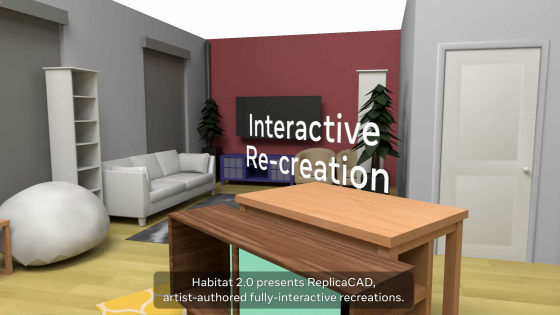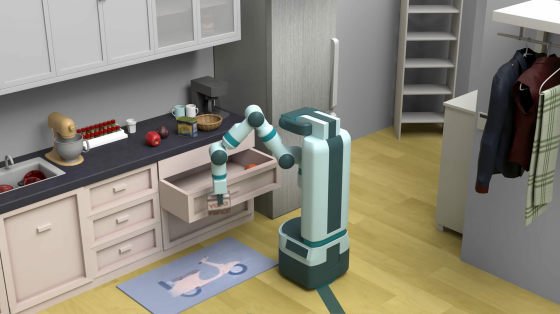Facebook announces 'Habitat 2.0' that accelerates learning by letting robots learn 'what is the real world' in virtual space

To create a robot that can act as an assistant in the house, it is necessary for the robot to learn 'what the real world is like'. Facebook has been developing `` Habitat'' to learn robots in virtual space from 2019, but it is said that it has newly realized an order of magnitude faster speed than existing simulations and realized an interactive simulation that has never been seen before. Announced ' Habitat 2.0 '.
Habitat 2.0: Training Home Assistants to Rearrange their Habitat
Habitat 2.0: Training home assistant robots with faster simulation and new benchmarks
https://ai.facebook.com/blog/habitat-20-training-home-assistant-robots-with-faster-simulation-and-new-benchmarks
In order to develop a robot that can play an active role as an assistant in a general household, it is necessary to simulate the movements required in the general household and let the robot learn in advance. However, simulation in a physical environment takes a lot of time. For this reason, Facebook has devised a way to simulate in virtual space and complete thousands of hours of training in minutes. Whole picture of this open-source simulator named 'Habitat' is, in a paper in 2019 have been announced .
[1904.01201] Habitat: A Platform for Embodied AI Research
https://arxiv.org/abs/1904.01201
And on June 30, 2021, Facebook announced 'Habitat 2.0'. According to Facebook, Habitat 2.0 extends Habitat's capabilities and is orders of magnitude faster than existing 3D simulators. This allows Habitat 2.0 to perform billions of real-world actions, including complex tasks such as 'setting a table' and 'storing food in the refrigerator.' The advantage of Habitat 2.0 is that it can perform interactive simulations as well as simulations in a static 3D environment.
You can check the Habitat 2.0 simulation from the movie on the following page.
Habitat 2.0: Training home assistant robots with faster simulation and new benchmarks

The following is a Habitat simulation released in 2019. It is a static simulation in which a robot moves around in a space with obstacles.

After that, Habitat was training AI agents in hundreds or thousands of virtual environments ...

Habitat 2.0 enables more dynamic simulation.

Habitat 2.0 runs around in a variety of residential virtual environments.

You can simulate more realistic movements such as 'opening a shelf', 'taking out an object', and 'carrying an removed object on a desk'.

Habitat's dataset, ReplicaCAD, was originally static 3D scan data, but Habitat 2.0 includes physical parameters, semantic annotations, etc., which enable 'manipulation' and 'movement' training. In addition, in order to give variation to the setting environment, 111 patterns of living space layout are prepared, and objects such as kitchen utensils, books, and furniture are also provided. These objects etc. were created by the artist, but because of the CC BY-NC 4.0 license, they can be used freely for non-commercial purposes.
In addition, Facebook is working with Matterport , a 3D data platform, to open source the 'largest indoor 3D scan data ever' used in Habitat 2.0.
Habitat --Matterport 3D Research Dataset | Matterport
https://matterport.com/habitat-matterport-3d-research-dataset

Related Posts:







